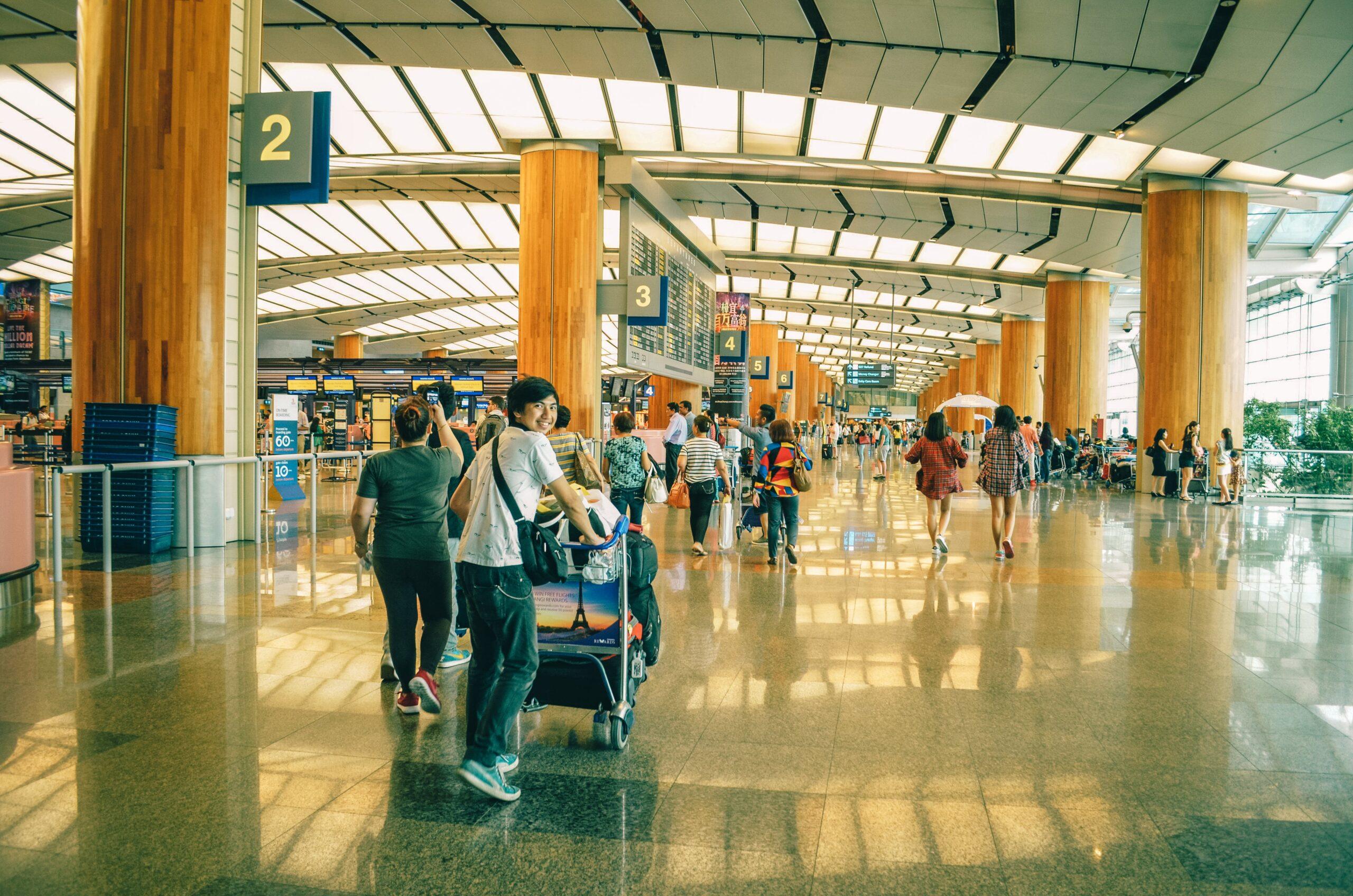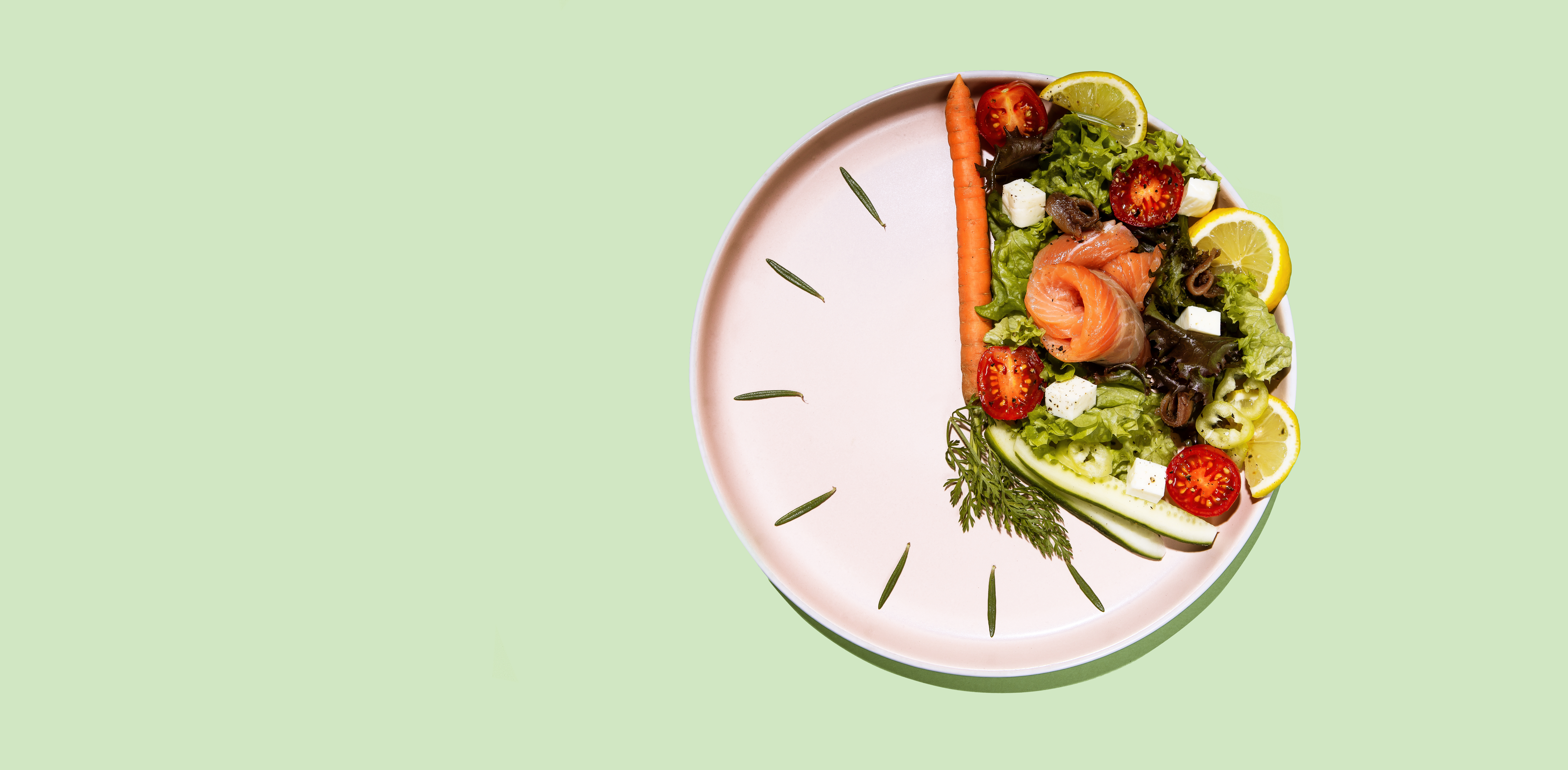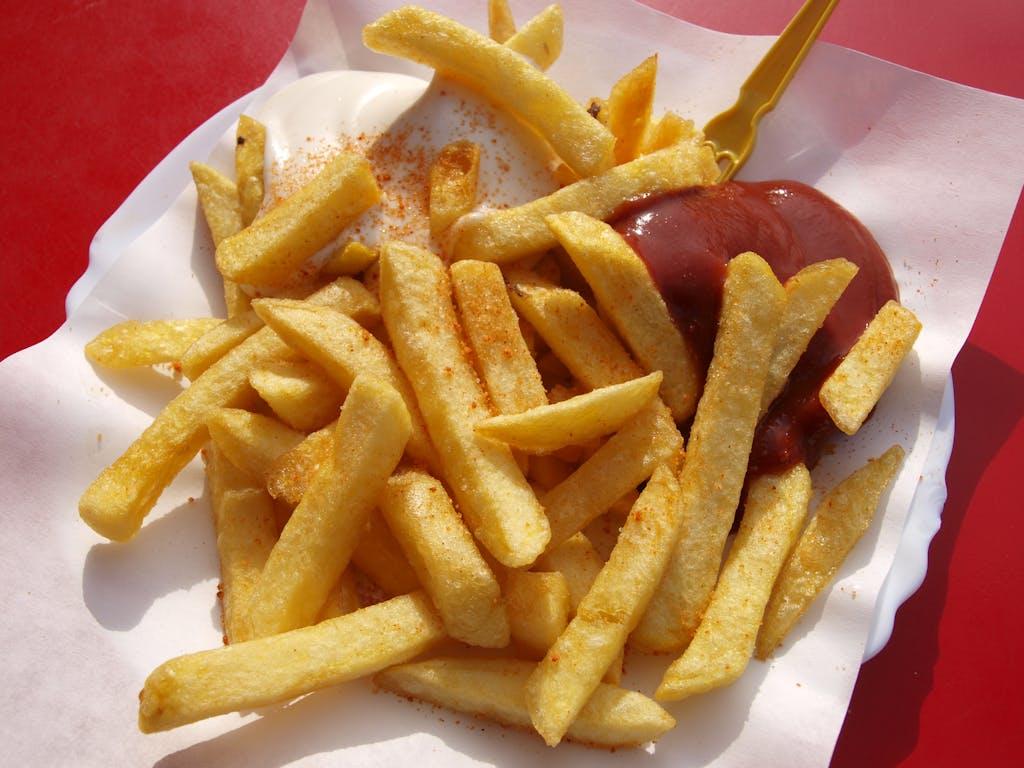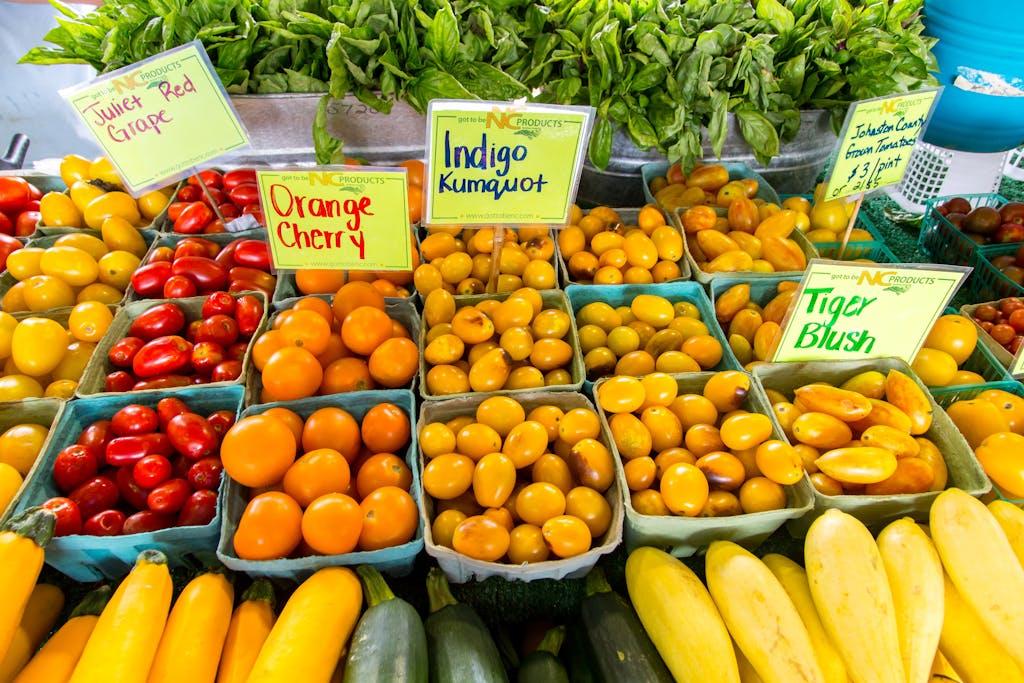Eating healthy while traveling may sound impossible, especially at the airport. Combining food concerns with the TSA regulations, long security lines, and flight anxiety that are already in the mix will just add to the overall stress of air travel.
While flying presents a unique challenge for maintaining healthy habits, Culina Health is ready with solutions. Wherever you’re flying off to, our dietitians have you covered!
The problem with airport food
Most foods you’ll find at the airport, while convenient, are ultra-processed and over-priced. Security regulations (more on them later) help airport terminals give big food corporations a captive audience. You’ll have to pay a premium for the convenience of purchasing food by your gate.
In addition, airport offerings leave much to be desired. Fast-food chains are among the only accessible choices if you’re hungry while awaiting your flight. Airport food may also lack options for people with dietary restrictions.
Food options are even more limited once you’re in the air. Most airlines provide complimentary beverages and packaged snacks, but these processed foods are often high in sodium, saturated fat, and added sugars.
Whether you’re consuming ultra-processed foods at restaurants in the terminal, or as snacks onboard the aircraft, these foods aren’t doing you any favors from a nutritional standpoint. In fact, they’re increasing your risk for several components of metabolic syndrome — including cardiovascular issues and obesity.
We’re here to support you with strategies to maintain healthy habits despite all the travel chaos. We recommend you plan ahead, know where to look, and use the resources available to you.
Plan ahead for healthy habits
Food might be an afterthought when you’re packing for a vacation, but it’s important to think about before you travel if you’re trying to maintain healthy habits. Planning ahead ensures that your hunger and health needs are met whether you’re waiting to board a flight or cruising at 30,000 feet.
Before you leave for the airport
Healthy choices start while you’re at home. Before you head out the door, eat a balanced pre-airport meal. This will keep you from feeling famished during or after your flight and result in less money spent at the airport. Our dietitians can work with you to plan a pre-flight meal that will keep you satiated throughout your trip.
What food to pack for the airport
We recommend packing food in addition to bringing clothes and toiletries. This is a sure-fire way to ensure that you’ll have something healthy to keep you satisfied during your travels.
Our RDs recommend you pack three essential components for any snack: fiber, fat, and protein.
- Fiber: bring along easy-to-pack fruits, such as apples, oranges, or bananas. Dried fruits also work, but are higher in sugar. This is something to keep in mind if you are watching your blood sugar. Pre-cut veggies are great, provided you have the time to prep them beforehand. High-fiber cereal also works! Those with celiac disease should look for a gluten-free granola or muesli mix.
- Fat and protein: try non-refrigerated items such as unsalted nuts or nut butters. You could also bring along cut-up avocado, cheese, hard-boiled eggs, or hummus provided you bring a few ice packs. Dried edamame or chickpeas also provide a good source of protein and are appropriate for those with lactose intolerance or egg allergies.
Granola bars can also be a good snack option, but be sure to take a look at the label. KIND offers certain bars with a low glycemic index, such as their Dark Chocolate, Nuts, and Sea Salt bar. A low glycemic index means it won’t spike your blood sugar quite as high. Lara bars and Rx bars are also good choices. Buying these before you head to the airport will definitely save you a few dollars.
Packing snack foods is especially important if you’re traveling with kids. Making sure your children stay adequately satiated and hydrated can keep them happy and ease your overall travel stress. Keep in mind what their favorite snacks are, and make sure to bring along a combination of fiber, protein, and fat. Apple slices with nut butter will provide these essential nutrients and appease your child’s sweet tooth without making them hyper on the plane.
You can help your family acclimate to pressure changes during the flight by making sure you have water, mints, or sugar-free gum on hand. Drinking fluids and chewing or sucking on mints or gum helps your ears adjust to changes in elevation during take-off and landing.
Avoid bringing a lot of processed foods, which are usually higher in salt and can make you dehydrated. Flying causes dehydration, so adding salty food to the mix just worsens things. Reducing your salt intake is also beneficial if you’re managing high blood pressure or hypertension.
Processed foods also tend to contain high amounts of added sugar. High-sugar foods lead to an inevitable sugar crash and can also result in cravings and GI concerns. If you do decide to opt for a sugary snack, pair it with some protein or a larger meal to prevent these symptoms.
Whether you’re managing special dietary restrictions or looking for additional healthy snacks for weight loss, Culina Health dietitians can help you brainstorm a personalized snack list in session.
Getting through security
Once you know which foods you’d like to bring on your flight, it’s important to make sure they are packed for TSA-compliance. You can take a look at the complete list of TSA’s food regulations, but we’ve also put together a few key tips for packing your carry-on snacks:
- Ice packs: these must be completely frozen when passing through security (cannot be partially melted into liquid).
- Water: bring an empty reusable water bottle. You can fill it up at a water fountain once you’re through security. It’s recommended that men drink 13 cups of fluids per day, while women drink nine cups. It’s especially important to make sure you’re drinking enough fluids since flying can dehydrate you.
- Powders: TSA recommends that any powder-like substances more than 12 ounces (or 350 ml) be placed in a separate bin from your carry-on bag and encourages packing these in checked bags. If you’d like to bring protein powder in your carry-on, bring only a small amount that is quickly accessible so that it is easy to find if additional screening is necessary.
- Nut butters, creamy dips, spreads, soft cheeses, and yogurts: must be in containers of less than 3.4 oz (or 100ml), as they are considered to be liquids or gels. We recommend purchasing these in small containers beforehand to confirm they meet the size specifications. Nut butters can be bought in small squeezable pouches, and dips such as hummus are often sold in smaller snack-sized portions. Alternatively, you can fill a reusable container that meets the size limits.
- Fresh fruits or vegetables: you may not be able to take these off the plane with you (due to the risk of spreading invasive plant pests) if you’re flying between the continental U.S. and Hawaii, Puerto Rico, or the U.S. Virgin Islands. Make sure to eat these snacks beforehand. It’s also a good idea to check regulations if you’re traveling internationally before packing these items.
Best meal to bring on a plane
A pre-airport meal or packed snacks may not be enough to tide you over if you’re taking a longer flight. Our dietitians recommend bringing a balanced meal to eat on the plane that includes fiber, fat, and protein sources.
However, it’s also important to consider food safety, especially if you’re traveling internationally. Food poisoning is the last thing you want during a long day of travel. It is important to bring non-perishable food items, as any foods that require refrigeration should be eaten within 2 hours.
While the “best” meal to bring on the plane depends on your individual preferences and dietary restrictions, sandwiches and oatmeal are some of our favorites. These options are both customizable and easy to pack.
You can make a balanced sandwich by starting with a whole grain bread for fiber, then add toppings with protein and fat. Some balanced combos are hummus, avocado, and greens; banana and nut butter; or cheese and veggies.
You can also pack instant oatmeal without added sugar. You can mix it either in the terminal or on your flight with hot water and add in your toppings! Some healthy options for toppings include dried or fresh fruit, seeds, nuts, nut butter, protein powder, or a small portion of dark chocolate.
“I spy”…identifying healthy foods at the airport
Packing food is always preferable, but it can also be difficult to accomplish when you’re in a rush. We recommend looking for balanced snack options at common airport retailers if you’re ever in this situation. Here are a few of our RDs favorites:
Healthy airport snacks
- Starbucks Protein Box
- Starbucks Oatmeal
- Dunkin Donuts Egg White Bowl
- Dunkin Donuts Veggie Egg White Sandwich on Multigrain Thin
- Dunkin Donuts Veggie Egg White Wake Up Wrap
You can also mix and match a la carte options from different vendors to build a healthy and filling snack. The choices below can be found at most airports:
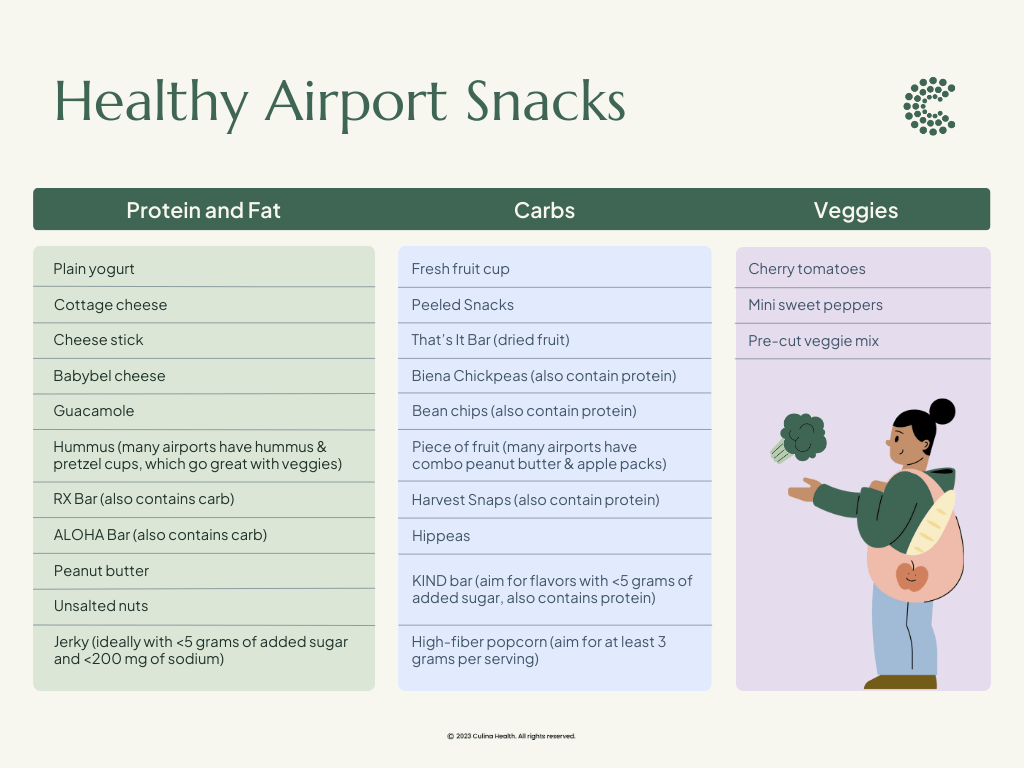
Things to avoid during air travel
If your main goal is a stress-free trip, it makes sense to avoid any stress-causing foods. This could be done by preparing snack options you enjoy beforehand or researching in advance the food options available at your airport.
You’ll also want to avoid any foods that dehydrate you, such as salty foods, caffeine, and alcohol.
Be sure to keep your dietary restrictions or goals in mind during travel. Don’t feel bad for making healthy choices, even if your travel companions are not. They should support you in making decisions that are best for your health and any conditions you may be managing.
How to sneak in some exercise
Take the opportunity to get some steps in if you have some time to wait before your flight or layover. You’ll be able to keep up with your fitness goals and stretch your legs by taking a walk around the terminal before sitting on a cramped flight.
It’s also possible to get some steps in while on the plane. Take a lap around the plane when the seat belt sign turns off before heading to the bathroom. In fact, if you’re at risk of developing a blood clot, it’s recommended that you stand up and walk around every 2-3 hours.
Quick tips to remember
- Hydration is key, especially while flying.
- Fiber, fat, and protein are essential components of a satisfying meal or snack.
- Avoid processed foods when possible.
- Eat like you’re at home, not like you’re on vacation.
- Sneak in some exercise wherever you can.
- Plan ahead for hunger.
- Don’t expect perfection—traveling can be unpredictable, and not every situation can be anticipated. Putting in the effort to maintain healthy habits, even if things go a bit awry, is an amazing goal in and of itself.
Work with a Virtual Registered Dietitian Nutritionist
Our team of Registered Dietitians Nutritionists are dedicated to helping you achieve your nutrition and overall health goals through virtual, telehealth sessions. Whether you have a specific health condition, particular dietary needs or preferences, or simply want to stay on track during your travels, our Registered Dietitian Nutritionists are here to support you.
One-on-one virtual nutrition care sessions with Culina Health Registered Dietitian Nutritionists are covered under most health insurance plans. Your Registered Dietitian Nutritionist will help you during your sessions to understand how food affects your body and work with you to create a personalized plan to meet your health goals, including access to healthy and delicious seasonal recipes.
Any general advice posted on our blog, website, or application is intended for reference and educational purposes only and is not intended to replace or substitute for any professional medical advice, diagnosis, treatment, or other professional advice. If you have specific concerns or a situation arises in which you require medical advice, you should consult with an appropriately qualified and licensed medical services provider.
